Viola emarginata (Nutt.) Leconte [sensu stricto]
Common names:
Triangle-leaved Violet
Synonyms:
Viola emarginata (Nutt.) Leconte, Ann. Lyceum Nat. Hist. New York 2: 142. 1828 ["1826"]; Viola sagittata Aiton var. emarginata Nutt., Gen. N. Amer. Pl.: 147. 1818. TYPE: "In the sandy fields of New Jersey near Philadelphia, and also on the banks of the Schuylkill" [this phrase appears to refer collectively to V. sagittata, not just to var. emarginata]. [Two sheets in the JSTOR Global Plants database, one at BM and one at PH, are labeled as types of Viola sagittata var. emarginata and are attributed to Nuttall. The BM000617507 sheet has only plants of V. sagittata sensu stricto on it and was collected in New York, a state not mentioned in Nuttall's protologue; it is excluded as type material. The PH sheet bears two separate collections, PH00029287 and PH00029288. The PH00029297 plants are typical Viola sagittata and do not match the protologue description, and the label is not in Nuttall's handwriting. The flowering plant of PH00029288, excluding the large leaf of V. sagittata attached next to it, does match the morphological features which Nuttall described for var. emarginata. Landon McKinney incorrectly annotated the whole PH sheet, with collections PH00029287 and PH00029288, as the holotype. Given the vagueness of the locality information in the protologue, the possibility of other specimens Nuttall may have used, and the absence of indications on the PH sheet regarding which might be the type, a lectotype must be designated. The smaller flowering plant in the upper left portion of sheet PH00029288 (excluding the leaf of V. sagittata) should be designated as the lectotype.
Description:
Growth form, foliage and peduncle color and indument same as the species; leaf blade outline during chasmogamous flower narrowly ovate-triangular or narrowly deltate-triangular, during cleistogamous fruit deltate-triangular to broadly so, base truncate to subcordate, margins crenate, eciliate (occasionally ciliate), apex acute to narrowly rounded, plants (at least in chasmogamous flower) producing uncut leaf blades (more common on the northeastern Atlantic Coastal Plain) or heterophyllous plants producing larger blades pedately divided with 1–2 basal incisions or 1–3 large broadly triangular or oblong basal lobes per margin; chasmogamous flowers, cleistogamous fruits and seeds same as the species.
Similar species:
See Viola emarginata [species complex].
Ecology:
Somewhat acidic, well-drained sandy soils in oak and oak-pine forests, and open sites along forest borders and roadsides adjacent to open woodlands.
Distribution:
Atlantic Coastal Plain in the northern portion of its range, the upper Atlantic Coastal Plain and Piedmont in VA and the Carolinas, MA (Bicknell 1914) south to SC, slightly disjunct in an isolated location in GA. I thank Arthur Haines for questioning the distributional error in citing Connecticut, when no confirmed specimens have been found from New England.
Rarity:
None.
Phenology:
Same as the species.
Affinities:
Same as the species.
Hybrids:
Hybridizes with V. affinis (Brainerd 1924), V. brittoniana (House 1906b, Brainerd 1906b, Brainerd 1924, House 1924), V. communis [or possibly V. "sororia glabrous" or V. "sororia hirsutula-like"] (House 1906b, 1924, Brainerd 1924), V. fimbriatula (Brainerd 1906b, 1924, House 1924, Harvey Ballard, pers. comm.), V. hirsutula (House 1906b, Malte & Macoun 1915, House 1924), V. sagittata (Brainerd 1906b, 1924), V. septemloba (House 1914, Brainerd 1924), V. sororia sensu stricto (Brainerd 1924), and V. stoneana (Brainerd 1924). Brainerd reported that these exhibit intermediate or recombinant characteristics of foliage, chasmogamous flowers, cleistogamous capsules and seeds (where these did not abort). Hybrids do not reproduce by chasmogamous flowers. Most produce either abortive cleistogamous capsules or capsules with substantial to highly reduced proportions of viable seeds. However, the hybrid with V. fimbriatula reportedly was fully fertile with no loss of viable cleistogamous seeds, while various hybrid plants with V. sagittata ranged from nearly sterile (almost no viable seeds) to scarcely subfertile (most ovules fertilized as viable seeds).
Comments:
Brainerd (1921b) mentioned that specimens in the southern part of the Atlantic Coastal Plain range of this taxon (he didn't separate V. emarginata sensu stricto from V. "emarginata Lower Midwest") lacked emarginate petals, but I have not found this to be true from examinations of numerous herbarium specimens and several populations in the field. At least in chasmogamous flower, plants with all leaf blades unlobed predominate in populations in New Jersey, whereas plants with leaf blades well lobed predominate in populations in North Carolina, with a rough trend of increasing proportions of lobed-leaved plants from north to south. Additionally, the species sensu stricto is widely distributed and relatively common on the northern Atlantic Coastal Plain region in DC northward to New Jersey, whereas the range of the species shifts upward onto the Piedmont and is mostly absent from the Atlantic Coastal Plain in the Carolinas southward. Bicknell (1914) discussed the local occurence of this species on Staten Island and Long Island in New York, and in Martha's Vineyard area of Massachusetts, the northermost confirmed site. Brainerd published var. acutiloba for plants in DC area exhibiting prominently lobed leaf blades during early chasmogamous flower. Although this name has been applied to plants with lobed leaf blades further south (e.g., the Carolinas, by Radford et al. 1968), specimens identified or annotated as var. acutiloba in DC and Maryland show features suggesting they are hybrids of V. brittoniana and V. sagittata, and the name is excluded here. The lobed-leaved plants are otherwise identical to unlobed-leaved ones, the two occur together in mixed populations throughout the range of V. emarginata sensu stricto, and they appear to represent a population-level leaf development polymorphism. No formal recognition seems required. Strausbaugh and Core (1978) noted that Davis and Core (1940) provided the first report of the present taxon from West Virginia, and that it had previously been misidentified as V. novae-angliae.
Literature Cited:
Alexander, E. J. 1963. Violaceae. In Gleason, H. A., The new Britton and Brown illustrated flora of the northeastern United States and adjacent Canada. Hafner Publishing Co., Inc., New York, NY. 552-567.
Bicknell, E. P. 1904. Three new violets from Long Island. Torreya 4: 129-132.
Bicknell, E. P. 1914. Viola emarginata in Massachusetts. Rhodora 16: 76-77.
Brainerd, E. 1906b. Hybridism in the genus Viola,-III. Rhodora 8: 49-60, plates 66-70.
Brainerd, E. 1921b. Violets of North America. Vermont Agricultural Experiment Station Bulletin 224: 1–172.
Brainerd, E. 1924. The natural violet hybrids of North America. Vermont Agricultural Experiment Station Bulletin 239: 1-205.
Davis, H. A. and E. L. Core. 1940. Spermatophytes new to West Virginia. Castanea 5(2): 20-23.
House, H. D. 1906b. The violets and violet hybrids of the District of Columbia and vicinity. Rhodora 8: 117-122, plates 71-72.
House, H. D. 1914. Violets new to southeastern Virginia. Torreya 14: 2-4.
House, H. D. 1924. Annotated list of the ferns and flowering plants of New York state. Family 83 Violaceae. New York State Museum Bulletin 254: 499-512.
Malte, M. O. and J. Macoun. 1915. Ottawa Naturalist 28: 145-150, 161-168.
Radford, A. E., H. E. Ahles, and C. R. Bell. 1968. Manual of the vascular flora of the Carolinas. University of North Carolina Press, Chapel Hill, NC. 1245 pp.
Strausbaugh, P. D. and E. L. Core. 1978. Violaceae. In Flora of West Virginia, 2nd ed. Seneca Books, Inc., Morgantown, WV. 644-658.
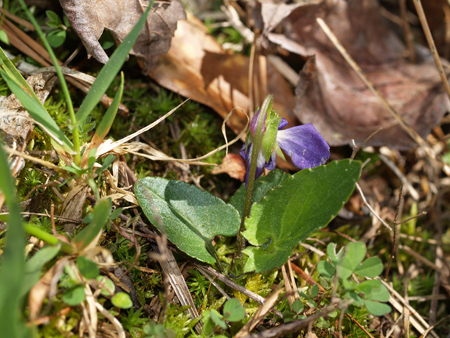
Chasmogamous flowering habit by Harvey Ballard
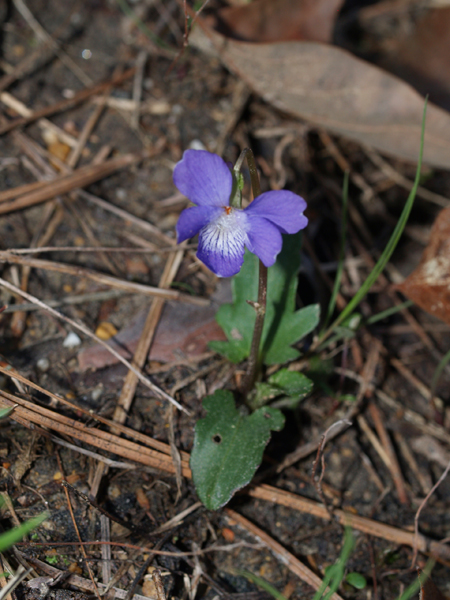
Chasmogamous flowering habit by Harvey Ballard
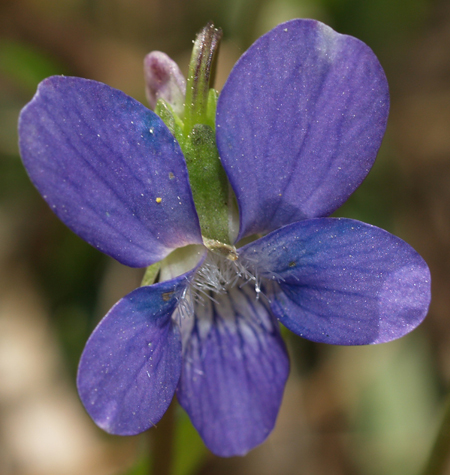
Chasmogamous flower front view by Harvey Ballard
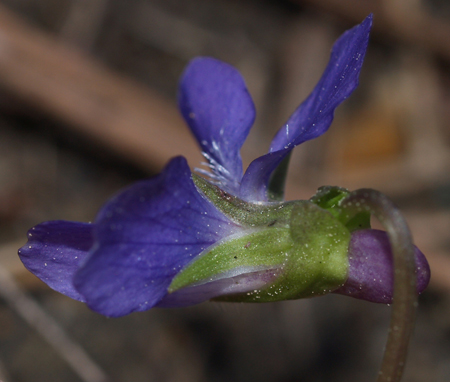
Chasmogamous flower profile view by Harvey Ballard

Seeds from herbarium specimen: Transplanted from NC, Cumberland Co., Fort Bragg, H. Ballard 15-006Y (BHO)

Seeds from herbarium specimen: Transplanted from NJ, Atlantic Co., Oslo Avenue, H. Ballard 15-022J (BHO)
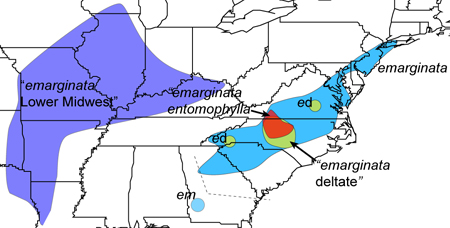
Map of V. emarginata species complex by Harvey Ballard